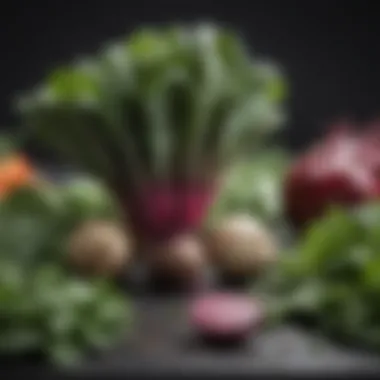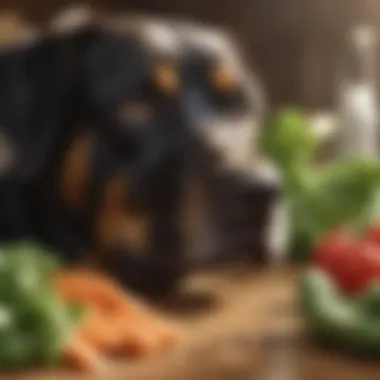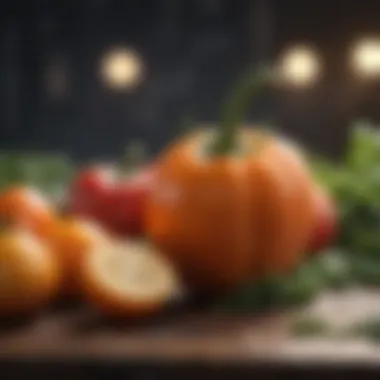High Oxalate Vegetables and Their Risks for Pets


Intro
The dietary choices we make for our pets can have significant health implications. Understanding the risks and benefits of various foods is vital for responsible pet ownership. Among these considerations are high oxalate vegetables, which can pose considerable health challenges for pets, particularly concerning their kidney function.
This guide seeks to elucidate the nature of oxalates, outline high-oxalate vegetables, and discuss their effects on pets' health. Moreover, it offers alternatives that are less harmful, aiming to ensure that pet owners can provide nutritious and balanced diets. A well-informed approach can safeguard your pets from the potential dangers associated with high oxalate foods.
Understanding Your Pet
Maintaining a robust understanding of your pet is key to making informed dietary decisions. A pet's behavior, breed characteristics, and specific needs play a crucial role in determining the kind of nutrition that is suitable for them.
Pet Behavior Basics
Pet behavior can often give insight into their overall health. Observing how your pet interacts with food may indicate preferences or aversions. It's essential to pay attention to any behavioral changes, as they can sometimes signal health issues rather than mere changes in mood or energy.
Common Breed Characteristics
Different breeds exhibit distinct health profiles and dietary needs. For example, certain dogs are more prone to urinary issues than others. Understanding the specific needs of your pet’s breed can guide you in choosing safe food options. For instance, breeds like Yorkshire Terriers and Shih Tzus may be more susceptible to developing kidney stones if they consume high-oxalate vegetables.
Species-Specific Needs
Furthermore, it is crucial to recognize the inherent differences among species. Cats, for instance, are obligate carnivores; thus, their dietary requirements significantly differ from those of dogs. Ensuring that each species receives the necessary nutrients, while avoiding harmful foods, is fundamental to their health and well-being.
Pet Care and Maintenance
Beyond diet, a comprehensive pet care routine includes various aspects that are important to maintain overall health. This includes feeding guidelines, grooming essentials, and hygiene practices.
Feeding Guidelines
In this context, understanding what constitutes a balanced diet is essential. Pet owners should consult veterinary resources or professionals to tailor their pets' diets. Incorporating a variety of vegetables can be beneficial, but it is vital to steer clear of those that are high in oxalate.
Grooming Essentials
Regular grooming aids in identifying potential health concerns. It can also contribute to preventing skin infections and matting, which can lead to more serious complications.
Hygiene Practices
Maintaining hygiene not only includes grooming but also encompasses feeding and living environments. Clean bowls and living spaces lessening the chances of health issues.
Health and Wellness
Monitoring the health and wellness of pets is an ongoing responsibility that includes routine vet check-ups, vaccinations, and recognizing signs of illness.
Routine Vet Check-ups
Annual or biannual veterinary check-ups help keep track of your pet's health over time. Vets can provide invaluable insights into dietary choices, especially concerning high-oxalate vegetables.
Vaccination Needs
Up-to-date vaccinations are crucial for preventing various diseases. Discuss with your veterinarian which shots are necessary based on your pet's age, health, and lifestyle.
Recognizing Signs of Illness
Being aware of the common symptoms of illness, such as lethargy or urinary changes, can result in earlier diagnoses, leading to better health outcomes.
Enrichment and Activities
Providing your pet with enrichment activities is essential for their emotional and physical well-being. This could include both indoor and outdoor activities tailored to suit their needs.
Indoor vs.
Outdoor Activities
Fluctuating between indoor and outdoor environments can cater to diverse energy levels and mental stimulation. Indoor activities such as puzzle toys promote cognitive functions, while outdoor activities encourage physical health.


Interactive Toys and Games
Toys that stimulate thinking or require interaction can be beneficial. Choosing safe materials is as vital as selecting toys that translate into enjoyable experiences for your pet.
Socialization Opportunities
Social interaction with other pets or families will enhance their well-being. Controlled environments for socialization are optimal for fostering comfort and confidence in your pet.
Understanding the nutritional and behavioral needs of your pets ensures their health and longevity. The choices made in their diets can significantly affect their quality of life.
This initial exploration sets the stage for deeper insights into high oxalate vegetables and how they impact pet health, ensuring that pet owners remain informed and vigilant in their dietary choices.
Intro to Oxalates
Understanding oxalates is crucial for pet owners. Oxalates are naturally occurring compounds found in various plants, especially vegetables. They play a role in how certain foods interact with your pet's health. For instance, high oxalate vegetables can present risks, particularly regarding kidney function and urinary health in pets. This section lays the groundwork for recognizing the implications of oxalate consumption in animal diets.
What are Oxalates?
Oxalates, or oxalic acid, are organic acids that plants produce. They can be found in a range of plant-based foods, including vegetables, fruits, and nuts. These compounds can bind with minerals, such as calcium, making it less available for absorption in the body. Some pets metabolize these oxalates well, while others may struggle, leading to possible health issues.
Why Should One Care About Oxalates?
- They can contribute to the formation of kidney stones in pets, particularly dogs and cats.
- Oxalates can cause irritation or inflammation in the digestive tract.
- Monitoring oxalates in diets can lead to better overall pet health.
Understanding Oxalate Metabolism in Pets
When pets consume foods with oxalates, their bodies metabolize these compounds in various ways. For some pets, oxalates are efficiently processed and excreted without adverse effects. However, in others, for example, breeds predisposed to kidney issues, oxalate accumulation can lead to serious health complications.
It's essential to recognize that some pets may show signs of distress from oxalate exposure. Identifying these reactions can aid in determining suitable dietary choices.
In essence, understanding how oxalates interact within your pet's body paves the way for better dietary management. By recognizing the effects of oxalate metabolism, you can make informed decisions that contribute to your pet’s longevity and overall well-being.
High Oxalate Vegetables
High oxalate vegetables play a critical role in the conversation surrounding pet nutrition. Understanding their significance helps pet owners make informed choices. These vegetables can cause health concerns, particularly relating to kidney issues and the formation of urinary crystals in pets. Moreover, recognizing the presence of oxalates in some popular vegetables is vital for maintaining a balanced diet for our furry companions. A careful analysis of these foods can guide pet owners in selecting safer and healthier options.
Common High Oxalate Vegetables
Spinach
Spinach is among the most common high oxalate vegetables. It is rich in vitamins and minerals, contributing to overall health. Spinach is also very popular for its versatility in pet diets. However, its high oxalate content can pose a risk. Pet owners should be cautious when including spinach in meals, weighing the nutritional benefits against potential health risks.
Some advantages of spinach include its antioxidant properties. But the risk of oxalate toxicity must be considered. It is crucial to balance the intake of spinach with low oxalate vegetables to minimize health concerns in pets.
Rhubarb
Rhubarb is another high oxalate vegetable often overlooked. Its tart flavor makes it a unique addition to various dishes for humans, but it should be avoided for pets. The key characteristic of rhubarb is that its leaves contain toxic levels of oxalates. This poses a serious health risk for animals who might consume it.
Unlike other vegetables, rhubarb does not offer nutritional benefits that would outweigh the dangers. It is advisable for pet owners to eliminate rhubarb entirely from their pets' diets to avoid potential toxic reactions.
Beet Greens
Beet greens are rich in nutrients but have high oxalate levels that warrant caution. The prominent feature of beet greens is their leafy texture and vibrant color. They are a beneficial source of vitamins. However, similar to spinach, their high oxalate content can lead to health issues such as kidney stones.
Pet owners should treat beet greens with care. They can be included in small amounts but should not be a staple in any pet's diet. Monitoring the overall vegetable intake is essential to ensure pets remain healthy.
Kale
Kale has grown in popularity among health-conscious individuals. For pets, kale also presents challenges due to its oxalate content. The bright green leaves are often viewed as a superfood. However, its high oxalate levels mean that moderation is key.
While kale is a source of vitamins A and K, pet owners should be mindful of providing it alongside other low oxalate foods. This will help mitigate the risk of oxalate-related health issues in pets.
Identifying High Oxalate Vegetables
Identifying high oxalate vegetables is crucial for pet nutrition. Proper education on this topic empowers pet owners to make better dietary choices. Reading labels, doing research, and consulting with veterinarians are all practical steps in this process. By fostering awareness, it is possible to maintain pet health effectively.


Health Implications for Pets
The health implications of high oxalate vegetables cannot be overstated when it comes to pet nutrition. Understanding these effects is crucial for pet owners. High oxalate intake can lead to significant health issues in pets, particularly impacting their renal systems and urinary health. This section covers the potential risks tied to these vegetables, including kidney stones, urinary tract issues, and digestive problems. Knowing these risks helps pet owners make better dietary choices for their companions.
Oxalate-Related Health Issues
Kidney Stones
Kidney stones represent a serious concern for pets consuming high oxalate vegetables. These stones form when oxalate binds with calcium in the urine, leading to crystallization. Pets with a predisposition to urinary issues may find themselves at a greater risk. The formation of these stones can obstruct the urinary tract and cause significant pain in pets.
The most notable characteristic of kidney stones is their potential to cause acute distress. This contributes to the overall health topic as it emphasizes the need for careful dietary management. The unique feature of these stones is that they often require surgical intervention if they are large enough to cause blockages. This is why understanding their implications is a vital part of this article.
Urinary Tract Issues
Urinary tract issues can stem directly from high levels of oxalates in a pet's diet. High oxalate consumption increases the risk of developing urinary crystals, which can lead to infections or even blockages. Pets may experience discomfort during urination, showing signs of frequent attempts to urinate or straining.
The key characteristic of urinary tract issues is their pervasive nature, as they can affect pets of all ages and breeds. Recognizing these implications is beneficial because it drives home the importance of monitoring dietary oxalate levels. The unique feature here is how quickly these issues can escalate into more severe health consequences, necessitating immediate veterinary attention.
Digestive Problems
High oxalate vegetables can also lead to digestive problems in pets. Pets consuming these foods may experience gastrointestinal distress, including vomiting or diarrhea. This reaction is due to the inability of some pets to metabolize oxalates effectively.
The most prominent characteristic of digestive problems is their immediate impact on pet well-being. Addressing this issue is essential in this article, as it reinforces the broader risks associated with high oxalate consumption. One unique feature of these problems is the difficulty in identifying their root cause, as symptoms may mimic other conditions. This complexity adds depth to the discussion surrounding pet nutrition.
Signs of Oxalate Toxicity in Pets
As pet owners, it is critical to recognize the signs of oxalate toxicity. Pets may display behavioral changes such as lethargy or decreased appetite. Observing any unusual urination patterns, whether increased frequency or straining, signals possible health issues. Other symptoms can include vomiting, diarrhea, and abdominal discomfort. Monitoring these signs can help ensure timely veterinary intervention and better health outcomes for pets.
Considerations for Pet Diets
When it comes to the health of our pets, diet plays a pivotal role. The consideration of what goes into their meals can determine not just their immediate well-being, but also their long-term health. Understanding high oxalate vegetables and their implications helps pet owners make informed choices.
A balanced diet is key for pets. This means they need nutrients from varied sources, not just one kind of food. It is also essential to be aware of the specific dietary needs of different pets, as these can vary widely based on species, age, and health conditions.
Evaluating Your Pet’s Diet
Evaluating a pet's diet involves looking closely at the options available. Many pet owners may offer a range of vegetables in their pets’ meals. However, not all are appropriate. High oxalate vegetables can pose a risk. Therefore, recognizing which vegetables are safe is critical.
Some steps to evaluate your pet’s diet include:
- Reviewing Commercial Diets: Many packaged pet foods do not clearly indicate their oxalate content. Always read labels carefully. Ingredients should be appropriate for your pet's specific requirements.
- Consulting with Vets: Discuss with a veterinarian about your pet’s diet. They can provide crucial insights into the nutritional balance needed for your pet, including a focus on oxalate levels.
- Monitoring Health: Pay attention to your pet's health indicators, including energy levels, coat condition, and stool regularity. Changes can indicate dietary issues.
This evaluation should be an ongoing process rather than a one-time assessment. Pets can have changing health needs that require diet adjustments over time.
Importance of Variety
Providing variety in your pet's diet is incredibly important. While consistency is comforting, a diverse range of foods ensures a balanced intake of nutrients, enhancing overall health.
- Nutritional Balance: Different foods offer different vitamins and minerals. This helps in building a stronger immune system and reduces the risk of diseases.
- Preventing Allergies: Varied diets can help lower the chances of developing food allergies. Pets can react poorly to repetitive ingredients.
- Enhancing Palatability: Offering different bases makes mealtime more interesting for pets. Boredom can lead to decreased appetite, affecting their nutrition.
Incorporating low oxalate vegetables, like carrots and green beans, can safely provide variety without health risks. The goal is to keep meals appealing while ensuring safety and nutritional value.
A well-rounded diet is fundamental to a pet’s quality of life.
Safer Vegetable Alternatives
When it comes to feeding pets, it is crucial to choose vegetables that are safe and beneficial. High oxalate vegetables can contribute to health issues, particularly affecting kidneys and urinary tracts. For this reason, exploring safer vegetable alternatives is essential. Choosing low oxalate options can help maintain your pet's health while still providing variety in their diet.
This section will cover specific low oxalate vegetables that can replace higher-risk options. Additionally, I will address best practices for ensuring these vegetables are integrated safely into pet diets.
Low Oxalate Vegetables for Pets
Carrots
Carrots are a popular low oxalate vegetable choice for pets. They are rich in beta-carotene, which benefits eyesight and overall health. One of the main features of carrots is their crunchiness. This aspect is appealing to pets, making them a satisfying snack. The high fiber content also aids in digestion, contributing to a healthy gut.


While carrots are nutritious and generally safe, they should be given in moderation. Too many carrots can lead to excessive sugar intake, as they contain natural sugars.
Zucchini
Zucchini stands out for its versatility in pet diets. It is low in calories and high in water content, making it a great way to keep pets hydrated. The key characteristic of zucchini is its soft texture when cooked or raw. Many pets enjoy this vegetable, making it easy to incorporate into meals.
A unique feature of zucchini is its high vitamin C content, which supports the immune system. However, pet owners should be cautious not to overfeed zucchini. Too much can cause digestive upset in some animals.
Broccoli
Broccoli is another excellent low oxalate vegetable for pets. This vegetable is packed with vitamins and minerals, contributing positively to a well-rounded diet. Its key characteristic is the presence of antioxidants, which can help reduce inflammation and boost overall health.
One advantage of broccoli is its ability to be served raw or cooked. However, it should be noted that some pets may have difficulty digesting cruciferous vegetables. Moderation is key with broccoli, ensuring it fits well within the overall diet.
Green Beans
Green beans are a nutritious option for pets that love crunchy snacks. Their low calories and fiber content make them an excellent addition for weight management. The primary benefit of green beans is their ability to provide volume without excessive calories. They are often fed cooked or steamed and are well-received by many pets.
A unique feature of green beans is their high vitamin K content, which supports bone health. However, just like other vegetables, they should not form the entirety of a pet's diet. Balancing green beans with other food groups is essential for pet wellness.
Incorporating Vegetables Safely into Pet Diets
Incorporating vegetables into pet diets takes a bit of planning but offers numerous benefits. First, always wash vegetables to remove pesticides and chemicals. Next, introduce new vegetables gradually. This allows pets to adapt, reducing the risk of digestive upset.
When presenting vegetables, it is best to chop them into small pieces. This makes it easier for pets to chew and digest. Cooking vegetables lightly can also enhance digestibility while retaining essential nutrients. However, avoid using seasonings or salt, as these can be harmful to pets.
In summary, offering safer vegetable alternatives can lead to healthier pets. Selecting low oxalate options like carrots, zucchini, broccoli, and green beans allows pet owners to provide nutritious snacks without the risks of high oxalate content. By following best practices in incorporating these vegetables, you can maintain a balanced and safe diet for your beloved animals.
Consulting with Veterinarians
Pets are integral members of our families, and their health should be a top priority. Consulting with veterinarians is a critical aspect of managing your pet's diet, especially when it comes to understanding high oxalate vegetables. Knowledgeable veterinarians can help pet owners navigate the complexities of nutritional needs. They provide tailored advice that considers the specific health conditions, age, and lifestyle of the pet.
Veterinarians can offer insights into how oxalates affect pets. For instance, pets that are predisposed to kidney issues may need stricter dietary guidelines. Regular check-ups allow pet owners to ask questions and clarify concerns about suitable foods. This discussion can prevent potential health complications that may arise from consuming high oxalate vegetables.
Understanding when to contact your vet is crucial, but knowing what information to seek is equally important.
When to Consult a Vet
Consulting a veterinarian is advisable under various circumstances regarding your pet's diet. Here are key instances:
- Signs of Distress: If your pet displays unusual behavior or signs of illness after eating new foods, immediate consultation is necessary.
- Change in Diet: When introducing new vegetables into your pet’s diet, it's wise to consult a vet first to ensure the safety of these foods.
- Health Issues: If your pet has existing conditions like kidney stones or urinary problems, a vet’s guidance is essential to avoid high oxalate vegetables.
- Confusion about Nutrition: If you are unsure about the vegetables that are safe for your pet, consulting a veterinarian can provide clarity.
By addressing these situations proactively, you reduce the risk of serious health concerns for your pet.
Customized Nutrition Planning
Customized nutrition planning is perhaps the most beneficial service a veterinarian can provide. Each pet is unique, with different dietary requirements based on size, breed, and health history. A vet can develop a personalized nutrition plan that minimizes the inclusion of high oxalate vegetables while ensuring balanced nutrition.
This plan might include:
- Active Monitoring: Keep track of how high oxalate vegetables affect your pet's overall health.
- Substitutes for High Oxalates: A veterinarian can recommend safe vegetable options high in nutrients but low in oxalates, such as carrots or zucchini.
- Adjustments Based on Life Stage: Puppies and kittens have different nutrition needs compared to older pets, and these should be taken into account.
A tailored diet can help not just in avoiding health risks, but also ensures your pet thrives and lives a long, healthy life.
Epilogue
The significance of understanding high oxalate vegetables cannot be overstated when it comes to the health of pets. High oxalate levels in certain vegetables can precipitate serious health issues, particularly for animals like dogs and cats. This section emphasizes that informed dietary choices are beneficial for pet owners. By grasping the nature of oxalates and their potential health effects, pet owners can avert complications such as kidney stones and urinary tract problems.
The Balanced Approach to Pet Nutrition
When considering a pet's diet, balance is essential. It involves more than just avoiding high oxalate vegetables. It requires a comprehensive understanding of nutritional needs that vary according to the pet's age, breed, and activity level.
Key elements of a balanced diet include:
- Protein source: Ensuring a high-quality protein source to support muscle health, such as chicken or lamb.
- Carbohydrates: Integrating easily digestible carbohydrates, which provide energy without burdening the digestive system.
- Vitamins and minerals: Including a wide range of vitamins and minerals for optimal health; this helps avoid deficiencies that can cause various health problems.
- Adequate hydration: Always provide fresh water to maintain hydration, especially if dry food is being given.
By avoiding high oxalate vegetables and opting for safer alternatives, pet owners can ensure their pets enjoy a nutrition plan that supports vitality and health. Incorporating vegetables that are low in oxalate and rich in nutrients can enhance digestion and promote overall well-being.
A thoughtful approach to diet will significantly reduce the risk of oxalate-related health issues, leading to a longer, healthier life for pets.
To conclude, maintaining a balanced approach to pet nutrition is crucial. It encourages pet owners to remain vigilant about the inclusion of vegetables, considering their oxalate content without eliminating them altogether. A well-rounded diet tailored to individual needs becomes the foundation of not only health but also longevity in pets.







